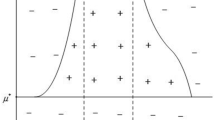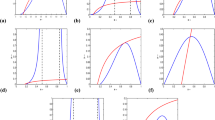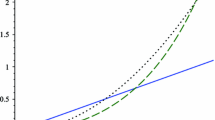Abstract
Spatial component of ecological interactions has been identified as an important factor in how ecological communities are shaped. In this paper, we consider a Holling–Tanner model with spatial diffusion. Choosing appropriate parameter values in parameter spaces, we obtain rich patterns, including spotted, black-eye, and labyrinthine patterns. The numerical results show that predator–prey system can exhibit complicated behavior.
Similar content being viewed by others
References
Turing, A.M.: The chemical basis of morphogenesis. Philos. Trans. R. Soc. Lond. A 237, 37–72 (1952)
Li, L., Jin, Z.: Pattern dynamics of a spatial predator–prey model with noise. Nonlinear Dyn. (in press)
Medvinsky, A.B., Petrovskii, S.V., Tikhonova, I.A., Malchow, H., Li, B.L.: Spatio-temporal complexity of plankton and fish dynamics in simple model ecosystems. SIAM Rev. 44, 311–370 (2002)
Sun, G.-Q., Jin, Z., Liu, Q.-X., Li, L.: Pattern formation induced by cross-diffusion in a predator–prey system. Chinese Phys. B 17, 3936–3941 (2008)
Sun, G.-Q., Zhang, G., Jin, Z., Li, L.: Predator cannibalism can give rise to regular spatial pattern in a predator–prey system. Nonlinear Dyn. 58, 75–84 (2009)
Liu, Q.-X., Sun, G.-Q., Jin, Z., Li, B.-L.: Emergence of spatiotemporal chaos arising from far-field breakup of spiral waves in the plankton ecological systems. Chinese Phys. B 18, 506–515 (2009)
Liu, P.-P., Jin, Z.: Pattern formation of a predator–prey model. Nonlinear Anal. Hybrid Syst. 3, 177–183 (2009)
Liu, P.-P.: An analysis of a predator–prey model with both diffusion and migration. Math. Comput. Model. 51, 1064–1070 (2010)
Sun, G.-Q., Jin, Z., Li, L., Li, B.-L.: Self-organized wave pattern in a predator–prey model. Nonlinear Dyn. 60, 265–275 (2010)
Lou, Y., Ni, W.M.: Diffusion vs cross-diffusion: an elliptic approach. J. Differ. Equ. 154, 157–190 (1999)
Hsu, S.B., Hwang, T.W.: Global stability for a class of predator–prey systems. SIAM J. Appl. Math. 55, 763–783 (1995)
Peng, R., Wang, M.: Global stability of the equilibrium of a diffusive Holling–Tanner prey–predator model. Appl. Math. Lett. 20, 664–670 (2007)
Peng, R., Wang, M.: Positive steady-states of the Holling–Tanner prey–predator model with diffusion. Proc. R. Soc. Edinb. A 135, 149–164 (2005)
Hsu, S.B., Huang, T.W.: Hopf bifurcation analysis for a predator–prey system of Holling and leslie type. Taiwan. J. Math. 3, 35–53 (1999)
Braza, P.A.: The bifurcation structure of the Holling–Tanner model for predator–prey interactions using two-timing. SIAM J. Appl. Math. 63, 889–904 (2003)
Saez, E., Gonzalez-Olivares, E.: Dynamics of a predator–prey model. SIAM J. Appl. Math. 59, 1867–1878 (1999)
Hsu, S.B., Huang, T.W.: Uniqueness of limit cycles for a predator–prey system of Holling and Lesile type. Can. Appl. Math. Q. 6, 91–99 (1998)
Collings, J.B.: Bifurcation and stability analysis of a temperature dependent mite predator–prey interaction model incorporating a prey refuge. Bull. Math. Biol. 57, 63–76 (1995)
Wollkind, D.J., Collings, J.B., Logan, J.A.: Metastability in a temperature-dependent model system for predator–prey mite outbreak interactions on fruit trees. Bull. Math. Biol. 50, 379–409 (1988)
May, R.M.: Stability and Complexity in Model Ecosystems. Princeton University Press, Princeton (1973)
Shi, R., Chen, L.: The study of a ratio-dependent predator–prey model with stage structure in the prey. Nonlinear Dyn. 58, 443–451 (2009)
Sun, X.-K., Huo, H.-F., Xiang, H.: Bifurcation and stability analysis in predator–prey model with a stage-structure for predator. Nonlinear Dyn. 58, 497–513 (2009)
Wang, X., Tao, Y., Song, X.: A delayed HIV-1 infection model with Beddington–DeAngelis functional response. Nonlinear Dyn. 62, 67–72 (2010)
Pei, Y., Li, S., Li, C.: Effect of delay on a predator–prey model with parasitic infection. Nonlinear Dyn. 63, 311–321 (2011)
Murray, J.D.: Mathematical Biology. II. Spatial Models and Biomedical Applications. Springer, New York (2003)
Andresen, P., Bache, M., Mosekilde, E., Dewel, G., Borckmanns, P.: Stationary space-periodic structures with equal diffusion coefficients. Phys. Rev. E 60, 297–301 (1999)
Kuznetsov, S.P., Mosekilde, E., Dewel, G., Borckmans, P.: Absolute and convective instabilities in a one-dimensional brusselator flow model. J. Chem. Phys. 106, 7609–7616 (1997)
Callahan, T., Knobloch, E.: Pattern formation in three-dimensional reaction–diffusion systems. Physica D 132, 339–362 (1999)
Gunaratne, G., Ouyang, Q., Swinney, H.: Pattern formation in the presence of symmetries. Phys. Rev. E 50, 2802–2820 (1994)
Ipsen, M., Hynne, F., Soensen, P.: Amplitude equations for reaction–diffusion systems with a Hopf bifurcation and slow real modes. Physica D 136, 66–92 (2000)
Pena, B., Perez-Garcia, C.: Stability of Turing patterns in the Brusselator model. Phys. Rev. E 64, 056213 (2001)
Sun, G.-Q., Jin, Z., Liu, Q.-X., Li, L.: Dynamical complexity of a spatial predator–prey model with migration. Ecol. Model. 219, 248–255 (2008)
Author information
Authors and Affiliations
Corresponding author
Rights and permissions
About this article
Cite this article
Liu, PP., Xue, Y. Spatiotemporal dynamics of a predator–prey model. Nonlinear Dyn 69, 71–77 (2012). https://doi.org/10.1007/s11071-011-0246-5
Received:
Accepted:
Published:
Issue Date:
DOI: https://doi.org/10.1007/s11071-011-0246-5




